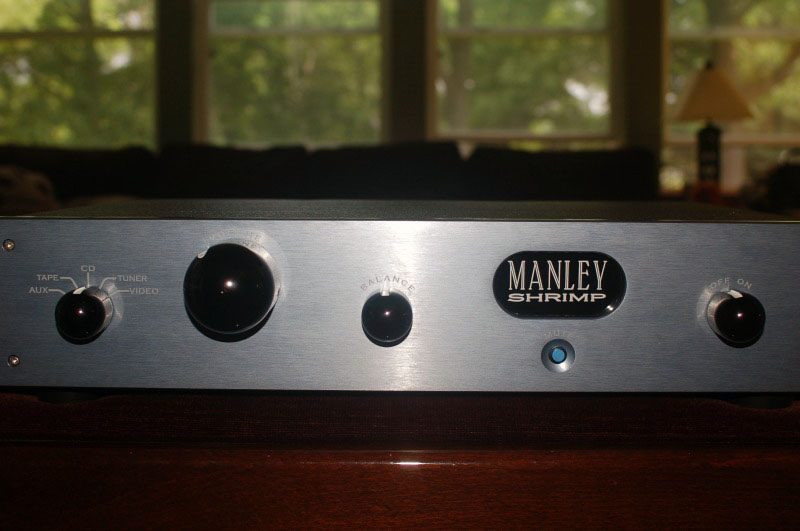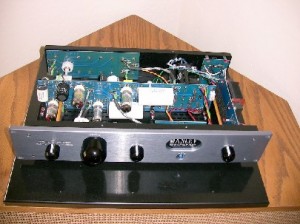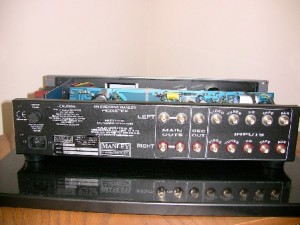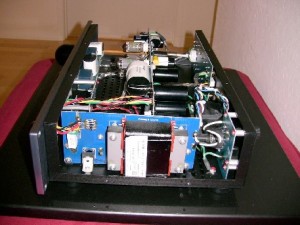Specifications:
- All –Tube: Vacuum Tube all-triode design
- Input Tubes: 2x 12AT7EH large plate Electro-Harmonix Russian
- Output Tubes: 2x 7044 GE JAN NOS Five line level inputs: unbalanced RCA Mute switch and Warm-up muting delay
- Noble volume control: Accurate tracking usually within 0.5dB Smooth operation (no detents)
- Noble balance control: center detented
- Record output: (AKA “TAPE OUT”) Unbalanced RCA jacks, unbuffered, passive (always on)
- Main Outputs: Two sets of unbalanced RCA main outs for bi-amping or driving a powered subwoofer
- Gain: 11.5dB
- Input Impedance: 250Kohm
- Input Sensitivity: 200mV in yields 1V out
- Maximum Input Level: 5V in produces 1.5% THD at output
- Frequency Response: 10Hz-80KHz; 20Hz-20KHz; -0.3Db
- Noise Floor: (shorted input) Typically –94 dB 20-20K with volume control fully closed
- Noise Floor: (shorted input) Typically –106dB A WGT 20-20K with volume control fully closed
- S/N Ratio: typically 95 dB A WGT 20-20K THD: 0.02% at 1V rms output
- Output Impedance: 50ohms
- Maximum Output: +23dBu @ 1.5% THD into 100K load (10.9V rms) Maximum Output: +20dBm @ 1.5 THD into 600 ohm load
- Power Consumption: 55 Watts (485mA @120VAC)
- Operating Mains Voltage: Units are purpose built for original destination country’s main voltage: 100V; 120V; or220-240VAC as indicated on the serial number badge.
- Power transformer must be replaced in order to change mains operating voltage.
- 120VAC units may NOT be rewired to put the primaries of the power transformer in series for 220-240V operation or a large radiated field of hum will develop. If changing locations/voltages, the power transformer must be placed with the dedicated one for the voltage at which it will operate.
- Mains Voltage Frequency: 50~60Hz Dimensions: W=19″; L=11″; H= 3 ½” Shipping Weight: 15 Lbs
Not only does EveAnna Manley have products for so many different occasions but she has managed to put together a website designed with that same goal in mind. I have visited countless sites and believe me the Manley Labs web pages are a fun filled sensation. Even if you never buy anything from Manley Labs (which is an absolute horrible thought) you just have to read through their many web pages if just to say you did it once. Its like climbing Mount Everest, you do it because its there. Once at the main page of http://manleylabs.com/ you will be treated to just a small glimpse of what is in store for you. Do yourself a favor, click on the website to visit with EveAnna Manley, and take your time, the experience will be well worth it.
Let me quote you from the sites FAQ (frequently asked questions), ” they don’t realize how big this website is. By “how big this website is” I mean nearly 6000 files, over 3500 pictures, nearly 17000 hyperlinks, and about 300MB of content to manage. It’s easy to make a website for 5 products. Harder with 140 products, decades of past historic info, and kabillions of other stuff of interest to be found here atmanleylabs.com” This gives you a little insight into how long Manley Labs has been around, and how many products they really do carry. As you can see they have everything from studio to hi-fi gear.
From my personal observations what a person writes, whether on websites or in reviews, tells a lot about that individual. I have never met EveAnna but the site is quick-witted, personal, kindhearted, insightful, funny, intelligent, professional and compassionate. Now that’s a lot to put into even 6000 files.
It should be noted that all Manley gear is made in the US, in Chino 35 miles east of Los Angeles, and not subbed out to China or elsewhere outside the US. This is a fact proudly stated on their website and something I think should be commended for in an era where profit, not patriotism, seems to guide too many people these days. Aside from that it is also good business to be able to oversee everything that is done with your product. Judging by the pictures and bios of the workers on the website EveAnna has many devoted employees who take personal pride in the work that they do. I am sure that is one of many reasons why Manley Labs products have continued to be such a huge success.
As for the Manley name, in relationship to both pro and home audio gear, it goes without saying that it is first rate. I wish I could spend time just sitting around listening to all EveAnna’s designs but alas, so much gear so little time.
Manley Shrimp preamplifier review
Today though I do have ample time to review and enjoy the Manley Shrimp Tube Preamplifier. This is an all tube linestage preamp with single-ended non-inverting circuitry that is entry level only from the point of view of Manley gear. Remember they do make the Neo-Classic 300B preamp, listing for $5250 and The Wave 24/96 DAC/PREAMP combo at $7500. In light of all this the Shrimp’s price of only $1880 truly is their bargain entry-level product.
One way of keeping the cost down is to eliminate the remote control we so often find ourselves dependant upon. I too can be lazy but getting up to adjust the volume is well worth the trade-off of a higher quality sound system. Doing this allows Manley Labs to use the money saved there to reinvest it elsewhere and to make a truly high-end product. The Shrimp uses a single-ended design (only RCA connections), not a balanced design, to keep things simple and less expensive. Beside as EveAnna says on her website, more “stuff’ added to the signal would take away from the pure sound of the Shrimp. As I have already mentioned this is a linestage preamp only so no phono stage is included. I certainly do love my vinyl and luckily I have a separate phono stage to pair with the Shrimp connected to its Aux input.
A place where the Shrimp does not skimp (please excuse the rhyme) is in its design concept and use of quality parts throughout. For example the Shrimp uses a high quality Noble stereo volume potentiometer as well as a Noble balance control. Also of note is its use of MIT/Multicap polypropylene audiophile-grade capacitors for signal coupling and two enormous 30uF Multicaps for use in the output stages. It appears that Manley products are also a fan of the White Follower output stage, which is found in the Shrimp as well as their more expensive and very famous $7300 Steelhead phono stage. Both these designs share their use of 7044 tubes. The 7044 tube was basically designed for computer applications and can take the constant beating of being turned on and off. Manley Labs stands behind the Shrimp with a 90-day limited warranty that is extended to a full five years if you fill out the warranty card and send it in before 30 days expire. The warranty is to the original purchaser and must be accompanied with proof of the date of purchase. This can also be done online for those who prefer this method of communication. Full details are of course found online or in the owner’s manual of the Shrimp. There are a lot of manufacturers that only offer a one or three-year warranty and I commend EveAnna for taking it to a five full years. I think it speaks volumes when a manufacturer stands behind their products with a strong warranty like this.
The top is made out of perforated metal for better ventilation and for those who like to see the tubes a glow. When I looked inside the Shrimp one of the first things I noticed was that the tubes are mounted horizontally and not vertically. The Shrimp uses two Electro Harmonix 12AT7’s on the input stage while using two GE 7044’s for the output stage. Next my eyes glanced over to the 30-microfarad output caps and I almost fell backwards onto the floor. They are enormous! Manley Labs sure did not spare any expense here to bring us top shelf parts. Turning my attention now to the rear of the linestage you find two main and one rec (for record out) as well as five inputs. The inputs are labeled, left to right respectfully (as you see them facing the rear of the unit), video, tuner, cd, tape and aux (for auxiliary). The lettering on the back of the preamp is unusually large, so much so that it immediately struck my attention. I liked it, as my old eyes need all the help they can get to see correctly and to plugs things into the appropriate location. It seems like there is more than enough RCA gold plated in’s and out’s for most of us. Also on the rear of the unit is the obligatory IEC connector so that we audiophiles may play more extensively with our toys. Of course lets not forget to mention the fuse holder located just above it in case the rare instance occurs that we actually need it.
But wait, we have yet to discuss the front of the Shrimp. I know I am going backwards here but I’m that type of a guy. Everyone that saw the Shrimp thought it was very elegant and distinctive. Two things they noticed right away was the very large volume knob slightly off center to the left and the Manley Shrimp name that lit up while being recessed behind a pane of Plexiglass. The front panel also has an input selector, a muting button with a beautiful blue light, as well as balance and power on/off knobs. The feel of those knobs was so nice that I was happy it did not come with a remote control. They felt so good in my hands and the volume knob glided smoothly with the easiest of touches, but not too easy rather just right. Having a volume control as large and round as the Shrimp’s was so comfortable that it was actually a pleasure to adjust the volume.
So far everything looks, feels and seems so well thought out, but how does it interact within my audio system? Remember I am replacing a solid-state passive preamp with a tube active preamp so just that alone will account for some changes.
Listening to Mary Chapin Carpenter’s Party Doll CD, I was immediately taken by “Twist and Shout” the version recorded live from the Super Bowl XXXI halftime show. What struck me was that the song sounded so “large”. The Shrimp lay out before me a soundstage that was truly spacious and open. The word musicality also comes to mind when describing the Shrimp’s characteristics. The song “Dreamland” from the same CD also reinforced my opinion of the Shrimp being clear, open and spacious. Here the song presented holographic images in spades.
Livingston Taylor, James Taylor’s brother, has been making albums for a very long time. The CD to buy is, Our Turn To Dance, and the title song is the greatest. It was so good I wish people would play it at all the high school graduations. Aside from the fact that I love the song’s meaning, Livingston’s fast delicate guitar work and folk style singing voice was a pleasure to listen to with the Shrimp. One of the Shrimp’s exceptional strong points is in its portal of both male and female singers as well as acoustical guitar reproduction.
Whether you are listening to a group of singers and want to hear them stacked neatly row behind row, two vocals doing harmony or one singing solo, the Shrimp will not let you down. I love listening to “Let It Be”, not the Beatles version but the one song by Carol Woods and Timothy T. Mitchum for the soundtrack “Across the Universe. Here you have both Timothy singing a beautiful solo and then you switch over to Carol’s powerful voice with a full choir behind her. This layering effect of multiple singers in a choir is something not so easy to achieve and many times a preamp just cannot get it as clear and transparent as the Shrimp does.
Next, I moved on to Santana’s classic Supernatural CD where I tested its bass response. Santana and company certainly put on a show and it is one that should not be missed. Here we have a host of exceptional performers and the legendary guitar work of Carlos Santana making for some mighty fine music on many different levels. “Maria Maria” tests a systems bass capability and the Shrimp did just fine. No wimpy tube bass but rather a good solid presentation was achieved. I have never quite heard Santana’s guitar on “Put Your Lights On” sounded so right. On “Africa Bamba” the guitar notes attack and eventual decay was just superb. At certain well-placed moments during the decay, notes just hung in the air long enough to make you feel the music and not just listen to it.
Now to test the Shrimp’s true capabilities I ventured into the SACD and DVD Audio realm. It was here that I noticed an extension in upper frequencies and low bass response. Naturally that is what these CD types do and the Shrimp allowed them to strut their stuff. First up was the SACD recording of The Best Of John Denver Live CD recorded at his Wildlife Concert in February of 1995. “Wild Montana Skies” was the song that had it all, John’s voice hanging in the night air, the open spacious sound of a live outdoor concert and even an audience were the Shrimp could reveal even the slightest details. Moving on to “Fly Away” I was captured by the sound of a distant flute playing off to the side as John sang. The Shrimp took the essence of his performance and lay it out before me in a very smooth manner rather than shock me with its glaring starkness as some preamps might.
Not one to forget the other format, DVD Audio, it was time for the classic, Hotel California with the Eagles. Here the Shrimp caught the bass notes just right as song after song captured the drums in a strong forthright manner without being overdone. The shimmer of the cymbals in the beginning of “Hotel California” was welcomed and did not have the edge to it that I have heard in some systems. One thing for sure is that the Shrimp does much
to tone down CD glare and rather puts a nice tube spin on things. It does this without being too rolled off on the highs or bloated in the bass, as can be the problem with some tube playback equipment.
I did not feel the need to replace either tubes or power cord on the Shrimp, as I was more than happy with the sound that it produced. However when I did exchange the stock power cord with a PS Audio Lab Cable II the difference was slightly more than subtle. I was immediately struck with a sense that the preamplifier had moved up between a half to a full step. Things seemed more at ease than it already was and bass notes were just slightly deeper. My power cord replacement was definitely a keeper and one I am glad I did. Since I had the extra power cords around I thought why not, but if I did not want to spend the money I can tell you I was quite happy with the Shrimp in stock form. As for tubes that I never did tinker with mainly because I did not have any 7044 subs to replace the stock GE’s with. Also missing from my bag of spare tubes was the 12AT7EH variety but the Electro Harmonix stock tubes worked just fine.
Now the Shrimp is anything but a shrimp. It has a large volume knob, large lettering on the rear inputs, is physically much larger than my own passive preamp and produces a wide, deep soundstage that rivals other preamps costing many times its price. The only thing shrimp about it is the $1880, which is low in comparison to high-end preamps of similar quality. The Shrimp allowed me to see through to the other equipment in my audio chain. I am not saying it was crystal clear, after all it is a tube piece, but was good enough that I felt I was actually hearing through to my amps and source components. Any change made in my audio system was readily perceived and obviously so.
For those that think $1880 is a tad high for their budget I ask you to reconsider. Sure you can find preamps listing for $1000 but Manley Labs is offering you a truly high quality first-rate tube preamplifier for only a little more and it is well worth the extra investment. A preamplifier is the heart of any great system and definitely a component not to be overlooked. With the Shrimp you will allow your system to grow over time without feeling the need to replace the preamp. If you however must squeeze out a budget I recommend you look to Manley Labs Stingray integrated amp at only $2250. I have yet to review it but I must admit to drooling over both its looks and specs.
Having EveAnna’s preamplifier in my house was a pleasure. It looked great, was not too heavy or awkward to move around, uses tubes that I am partial to, and was well balanced. Sometimes you examine equipment only to find that it is just too bass heavy or bass shy, too rolled off on the top, lacks clarity in the upper midrange or any host of other complaints. With the Shrimp EveAnna has “struck a cord” that is beautifully balanced in all departments while doing some exceptionally well. I had never felt that my room was limiting my speakers until I hear them interact with the Shrimp to produce a soundstage that I believe could have been extended with a larger room.
Listening late at night, at relatively low volumes, I enjoyed the Shrimp’s quiet detailed sound and huge holographic presentations. I came to love my time with EveAnna’s creation and was sad to see the Shrimp pass back to Manley Labs. Be careful because if you get the chance to audition a Shrimp you might just get smitten like I was. Not that there is anything wrong with that. If you do take the plunge get ready for a long stay in the ocean with your Shrimp. At this price range I doubt you are going to find anything more pleasurable or affordable for a long time to come.
The Listening Environment:
As for my room, I have so far keep it quite simple as far as any acoustic modifications are concerned. My wife has allowed me to take over our living room being that the only guests we know have our relatives. Their visits usually center on the family room, dinning area, backyard (when we barbeque) or home entertainment room for movies. She is not so keen however on any acoustic looking invaders entering our house at this time. The listening room is 18′ 8″ long by 13′ wide. The room’s cathedral ceiling starts at 8′ high then slopes upward to 13′ at its peak in the middle. Flooring is a soft hardwood covering with an oriental rug placed dead center in between (but not under) the listener and the audio system. There are no doors that open or shut into other rooms also there are two large openings one facing the speakers and the other to its side and slightly in front of the right speaker. As for my audio equipment it is tucked nicely inside of a Cherry Synergy Twin S30 Salamander audio rack.
Review equipment:
- Monarchy Audio SM-70 Pro Amps (2 run in mono single-ended configuration) Oracle Delphi Mk I turntable with custom made interconnects
- Grace 707 tonearm with Denon 301 II MC cartridge
- Whest PhonoStage.20 + MsU.20 power supply
- Sony DVP-S7700 CD/DVD Player (used as transport only) Monarchy Audio Dual 20-Bit D/A Converter
- Samsung DVD-HD-841 Up-Converting Universal Player
- Legacy Focus 20/20 speakers RTP-2ultimate Power supply box RTP-4ultimate Power supply box PS Audio Power Port Receptacle
- Blue Circle BC86 MKIII power line pillows (2) Anti-Cable speaker wire 10′ pair
- Anti-Jumpers for Legacy speakers
- Anti-Interconnects (2 pairs)
- Anti-Digital Interconnect single-shielded 1.5 meters in length
- Monarchy Audio AC-1 power cord one 6′ length (2) Tek Line PC-8 Signature Power Cords (2) 6′ lengths Mr-Cable Musician power cord 9′ length
- PS Audio Lab Cable II power cord 3′ length
- Black Diamond Racing Cones (#3 & #4) Audio Prism IsoBearing (Isolation Globes
- Cherry Synergy Twin S30 Salamander audio rack
from affordableaudio, By Anthony Nicosia



